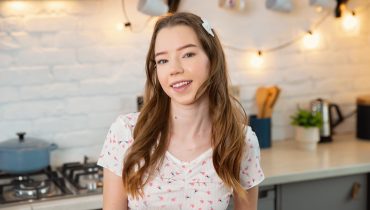For years, Ella Cooper thought of salt as harmless — just another seasoning that made life taste better. “I never questioned it,” she says. “A pinch here, a sprinkle there — what’s the big deal?” But at 42, sitting in her doctor’s office with elevated blood pressure and early signs of heart strain, she realized the truth: what she didn’t know about sodium could cost her health.
“It was a wake-up call,” Ella recalls. “I wasn’t overweight, I exercised, but my diet was quietly sabotaging me.” That day, she decided to learn everything about low-sodium diet plans for heart health — and in the process, she discovered not just how to lower her blood pressure, but how to rebuild her relationship with food itself.
From Salt Lover to Heart Advocate: Ella’s Turning Point
Ella’s story began like so many modern Americans. “I cooked at home, but I also loved takeout — Thai noodles, soups, sandwiches,” she says. “Even when I didn’t use the salt shaker, I was getting more sodium than I realized.” According to the Centers for Disease Control and Prevention (CDC), the average American consumes over 3,400 mg of sodium daily — far above the American Heart Association (AHA) recommendation of no more than 1,500–2,300 mg per day.
At first, Ella didn’t understand why sodium mattered so much. “I thought salt was just about flavor,” she laughs. But sodium controls fluid balance, blood pressure, and nerve function. Too much makes the body retain water, which raises blood volume — and that, over time, puts extra strain on the heart and arteries. “My doctor told me high blood pressure isn’t called the ‘silent killer’ for nothing,” she says. “You don’t feel it until it’s too late.”
That night, Ella went home, opened her pantry, and was stunned. “Everything had salt — soups, sauces, even cereal,” she says. “I realized the problem wasn’t my salt shaker; it was my entire grocery list.”
Understanding Sodium: The Hidden Risk
Ella began reading labels, something she’d never done before. “The first thing I learned? Sodium hides under dozens of names,” she says. Ingredients like monosodium glutamate (MSG), baking soda, sodium nitrate, and sodium benzoate all contribute to the daily load. “Even foods that taste sweet — like bread or pancakes — can be sodium bombs.”
The Mayo Clinic notes that processed foods account for more than 70% of the sodium Americans consume. That means even well-intentioned eaters are often exceeding healthy limits. “I realized I didn’t have to give up flavor — I had to give up ignorance,” Ella says. “Once I understood where the sodium came from, I could finally make changes.”
Designing Her Low-Sodium Diet Plan
Ella started slowly. “I knew going cold turkey would never work,” she says. Instead, she used a gradual reduction approach — cutting 25% of her sodium intake each week. “Your taste buds actually adapt,” she explains. “After two weeks, I couldn’t believe how salty restaurant food tasted.”
Her plan centered on three principles: awareness, balance, and substitution.
- Awareness: “I tracked everything — soups, snacks, dressings. I learned that one slice of store-bought bread can have 150 mg of sodium, while canned soups can exceed 800 mg per serving.”
- Balance: Instead of banning all sodium, she focused on the right range — 1,500–2,000 mg daily. “Your body needs sodium to function,” she says. “The goal is moderation, not deprivation.”
- Substitution: She swapped processed foods for whole ingredients — fresh vegetables, lean meats, herbs, and spices. “Garlic, lemon juice, smoked paprika — they replaced salt and made my meals come alive.”
Within a month, her energy improved, bloating disappeared, and her blood pressure dropped from 142/88 to 126/78. “It felt like my heart finally exhaled,” she says. “I didn’t realize how much sodium was weighing me down — literally.”
How the Heart Reacts to Lower Sodium
The science backs Ella’s results. The National Institutes of Health (NIH) reports that even a 1,000 mg reduction in daily sodium can lower blood pressure by 5–6 mmHg — a change that significantly reduces the risk of stroke and heart disease. “Those numbers might seem small, but for your heart, they’re huge,” says Dr. Mark Reynolds, a cardiologist at the Cleveland Clinic.
Ella also noticed mental clarity. “I didn’t expect that,” she admits. “But when your blood pressure stabilizes, your brain gets better oxygen flow.” The Harvard Health Publishing emphasizes that high sodium can constrict blood vessels and reduce nitric oxide, which affects not just heart function but cognitive sharpness. “I used to feel foggy at 3 p.m. — now I feel steady all day.”
Relearning Flavor: Cooking Without Excess Salt
One of Ella’s biggest fears was losing flavor. “I love food — I wasn’t ready to eat bland chicken and boiled vegetables,” she jokes. Instead, she took it as a creative challenge. “I bought every spice I could find — cumin, turmeric, smoked paprika, basil, dill.”
Her favorite discovery was citrus. “Lemon juice became my secret weapon,” she says. “It tricks your tongue into thinking something is salty.” Vinegar, chili flakes, and fresh herbs also became staples. “Now my meals taste more complex — I don’t miss the salt at all.”
She also learned that freshness equals flavor. “When ingredients are fresh, you don’t need to mask them,” she says. “A ripe tomato or roasted garlic has its own depth.” To enhance texture, she experimented with crunch and color — toasted seeds, roasted chickpeas, or pickled onions. “Cooking turned from routine into self-care.”
Smart Grocery Shopping for a Low-Sodium Lifestyle
Ella became a label detective. “The first rule is: if the label doesn’t say ‘low-sodium’ or ‘no salt added,’ assume it’s high,” she says. She discovered the AHA Heart-Check Food Certification — a red heart symbol that marks heart-healthy products. “It saved me hours at the store.”
She also learned grocery hacks:
- Buy frozen vegetables instead of canned — they usually contain no added sodium.
- Rinse canned beans and vegetables to remove up to 40% of sodium.
- Choose unsalted nuts and seeds for snacks.
- Look for “reduced sodium” versions of sauces, soups, and condiments.
Her shopping cart became a visual reminder of health: “Bright produce, lean proteins, and fewer boxes. It felt empowering.”
Social Life and Salt: Navigating Restaurants and Gatherings
At first, dining out was the hardest part. “Menus rarely list sodium content,” Ella says. She learned to ask politely for low-sodium options. “Most chefs are happy to accommodate if you ask nicely.” She also avoided sauces, dressings, and soups — the biggest sodium culprits. “Grilled, steamed, roasted — those became my go-tos.”
At social gatherings, she adapted. “I’d bring a dish I could eat — like quinoa salad with lemon dressing or roasted veggies with olive oil.” Over time, her friends joined in. “We started competing to make heart-healthy recipes. It became fun.”
Her advice to others? “Don’t make sodium reduction your identity — make it your habit. You can still enjoy life. It’s about mindful choices, not punishment.”
Beyond Blood Pressure: The Long-Term Benefits
Lowering sodium doesn’t just protect the heart — it benefits the entire body. Research from the CDC shows that reducing salt improves kidney function, bone density, and fluid balance. “My ankles used to swell after long days — that stopped within a month,” Ella says. “It’s incredible how quickly your body thanks you.”
Her skin even improved. “I didn’t expect that — but cutting sodium reduced water retention. My face looked less puffy.” The connection between sodium and inflammation is real; chronic high sodium can activate inflammatory pathways that contribute to aging and vascular damage. “My body feels lighter — inside and out.”
Building a Sustainable Low-Sodium Lifestyle
Ella emphasizes that success comes from mindset. “If you treat it like a diet, it feels temporary. But if you treat it like a lifestyle, it sticks.” She advises others to celebrate small victories — like choosing a fresh meal over fast food or skipping that salty snack. “Every gram of sodium you cut is a win for your heart.”
She also uses tech to stay accountable. “I track my meals in an app that calculates sodium automatically,” she says. Apps like MyFitnessPal or Cronometer help users log sodium intake, set daily goals, and visualize progress. “Seeing my sodium graph drop over time was oddly satisfying,” she laughs.
After a year, Ella’s doctor called her results “remarkable.” Her blood pressure normalized at 118/76, her cholesterol improved, and her resting heart rate dropped by ten beats per minute. “He said I’d lowered my risk of heart disease by almost half,” she says proudly. “That’s better than any prescription.”
Ella’s Advice for Anyone Starting a Low-Sodium Journey
She now mentors others through her local heart health support group. Her top lessons are simple but transformative:
- Start by tracking: Awareness is everything. Log your meals for one week — you’ll be shocked where sodium hides.
- Cook more often: Home-cooked meals give you control. Aim for at least five homemade dinners per week.
- Flavor smarter: Experiment with herbs, acids, and spices. Flavor doesn’t mean salt.
- Hydrate generously: Water helps flush excess sodium from the body and supports kidney health.
- Be kind to yourself: “It’s a learning curve,” she says. “Don’t quit because you had one salty day.”
Now, Ella doesn’t view her diet as restrictive — it’s liberating. “I’m not counting calories; I’m counting vitality,” she says. “Every meal is an investment in my future.”
Final Reflections
Looking back, Ella’s relationship with food has transformed from convenience to care. “I used to eat whatever was fast. Now I eat what makes me feel strong,” she says. She believes heart health starts with awareness — and small, consistent actions. “You can’t see your arteries getting stronger, but you can feel your life expanding.”
Her message is simple yet powerful: “Salt makes food taste good, but balance makes life good.” For her, a low-sodium diet plan isn’t about giving up — it’s about gaining longevity, clarity, and confidence. “My heart beats differently now,” she smiles. “And every beat is a reminder that change works.”
































































